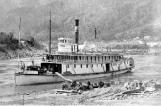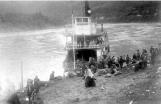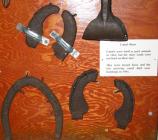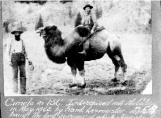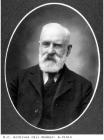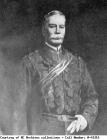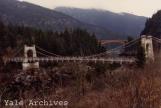1
TransportationYale sits at the bottom entrance to the nearly impassable Fraser Canyon, and was a challenge from the very earliest days, whether traveling by foot, horse or boat, or trying to construct a road or railroad.
The first people went on foot; the HBC traders used these native pathways they later called the Douglas Portage and Anderson Trail. Mule trains packed over the trails until James Douglas initiated the Cariboo Waggon Road, an incredible construction feat by the Royal Engineers (Sappers). From that point on pack trains, teamsters, and stagecoaches were a common sight throughout the Canyon and the Cariboo.
Downriver from Yale, which was the head of river navigation, shallow-draught steamships, called paddlewheelers or sternwheelers, brought passengers and freight to Yale from Victoria, New Westminster, Fort Langley, and Fort Hope.
Later the Canadian Pacific Railway would tear up the wagon road to replace it with shining steel rails, at a tremendous loss of life and limb.
Another railway, the Canadian National would run parallel on the opposite side of the river, and in 1926 the Fraser Canyon Highway was built so that automobiles could travel into the Interior.
The final road construction boom was the Trans-Canada Highway through Yale, completed in 1964-65, with a total of seven tunnels through the formerly impassable mountains. The barriers were finally broken, though every once in a while Mother Nature takes hers back by sending snow-slides that can trap travellers for a week.
In Yale's early days, transportation was intricately linked with communication. The invention of the telegraph lessened the necessity of a message being passed through physical travel to reach its destination. As such, each advance in transportation widened Yale's access to the 'outside world,' but, it also made her importance within the colony a little bit less significant as each phase of transportation was completed.
4
Jean Jacques Caux1830 – 1922
‘Cataline the Packer'
Jean Caux, or ‘Cataline' as he was called, was the most famous pack train driver in British Columbia. He was notorious for rubbing whiskey into his long curly black locks, saying "A liddle insida, a liddle outsida; Bon! She maka da hair grow!"
He was best known for being the most honest and reliable packer on the Cariboo Trail. Many of the miners and prospectors would head for the goldfields near Barkerville confident that Cataline would soon arrive with mules loaded full of supplies.
It is said that he never lost a load, except for the one the time when one of his men threw away an evil-smelling package from one of the loads, thinking something had gone rotten. When the man who had ordered the smelly Limburger cheese asked for it, Cataline found out what had happened to the package and made good for it, perhaps paying for it, or replacing it if he could on the next trip.
There are many legends attributed to him, such as his daily ritual beginning with a bath in the icy waters of the nearest stream; or a good roll naked in the snow every winter morning. Perhaps this was to wash out the previous evening's whiskey from his hair.
Another amusing story took place when he had to escort a company of soldiers from Telegraph Creek to the Yukon in 1898. The officer in charge was pompous and arrogant, and insisted on much bugle blowing during the trip. Cataline was very annoyed with this, complaining, "Alla time blowa da buga, no good, scara da mula!" The officer ignored his protests, and continued with his ritual bugle-calls. At one point on the trail they had to cross a corduroy road (built of logs) over a swamp, and one of the soldiers startled a lagging mule by whipping it. The unfortunate animal toppled over into the quagmire onto his back, his load stuck in the bog, kicking his legs helplessly. The soldiers strained and struggled to get the mule unstuck and up, all to no avail. When Cataline rode back to have a look, the officer looked beseechingly at him and asked, "What shall we do, Mr. Cataline?"
Caux stared triumphantly at him, and declared, "Blowa da buga! Blowa da buga!"
Cataline was also known for being the longest and oldest packtrainer in B.C. He began his packing career in Yale during the 1858 Gold Rush, and packed for 55 years until he retired in 1913 at the ripe old age of 83.
When Caux first landed in Yale he met a man who was from a town only 7 miles from the French Pyrenees village where he grew up. This fellow Frenchman was Joe Castillou and they became partners in the business of mule trains. Joe had to translate for Cataline, as he is said to have had a poor command of English. Another Cataline legend was that he could swear in seven languages when his hot temper possessed him.
One story told by Judge Henry Castillou, the son of Joe, was that Cataline and his father had a nice little trick that they played on newcomers. For years a little white mare that wore a bell around her neck headed the pack train and the mules & horses would follow this sound. The partners had her trained to do a little trick. Caux was a sturdy fellow with broad shoulders and a barrel chest, strong as a bull, and as he was swinging heavy loads up onto the mules' backs there always seemed to be a greenhorn who would comment on his strength. Cataline would answer, "Oh, dat's nothing. My partner Joe, he can lift a horse."
Of course, the greenhorn would be skeptical, and Caux would bet him a bottle of rum, whiskey or his favourite, cognac. He would call to Joe, "Hey Joe, bring dat white bell mare here!"
The little bell mare weighed no more than 450 pounds, and Joe was a solid strong man himself. He would squat down and wrap his arms around her legs. The mare would fold up her legs under her, as she was trained to do, and for a few moments Joe would be holding her above the ground. The amazed newcomer would gladly spring for the bottle of spirits after seeing this feat, and might buy a round of drinks for the packers before they departed on the trail.
They say that Cataline ran four pack strings at one time, at first with his partner Joe. Each string usually had 50-65 mules and horses in it. Sometimes they packed for James Teit, one of B.C.'s most famous ethnographers. More often they packed for the Hudson's Bay Company, and there is a record of Cataline eventually buying a mule train from the HBC.
At some point Castillou and Caux parted ways. Joe decided to go ranching in Merritt, and Cataline continued to run his trains north from Ashcroft after the Canadian Pacific Railway was built and took over the Fraser Canyon route.
While Cataline was based out of Yale he had an aboriginal marriage to a woman from Spuzzum, C'eyxkn (Amelia York). Amelia and Jean Caux had two children together, Rhoda Dominic and William Benjamin York. Cataline's grandchildren were Annie York and Arthur Urquhart, both well known to the ethnological community for their knowledge of Fraser Canyon history and native ways, traditions and medicines. The relationship with Amelia did not last, and she later married other husbands and had more children.
Sometime in his travels, likely about 1879-80, Jean Caux visited Wrangell, Alaska, and met a woman called Mary. They had a daughter in 1880, Clemence. During the first year of her life Clemence and her mother moved to Victoria and lived there for the rest of their lives. Clemence attended St. Anne's Academy and later married Anton Heggen Lynn.
Jean Caux continued his life of packing. He ran his trains out of Ashcroft, and also had a ranch at Dog Creek where he wintered his stock at Marble Canyon. While on the Cariboo Road, Judge Begbie naturalized him as a Canadian citizen. He may have been based out of Quesnel for while, but his main home and base in later years was Hazelton (now called Old Hazelton). He made quite a name for himself there, and made lifelong friends as well. He was a good friend of Sperry ‘Dutch' Cline, a local policeman who wrote about him, and George Biernes, a rancher who bought out his packtrain when he retired, and gave him a cabin to live in on his ranch.
Biernes is also known for being the go-between for Simon Peter Gunanoot when he gave himself up to authorities after being on the run for 13 years in the bush, wanted for murdering two men. Gunanoot was eventually acquitted after a trial in New Westminster.
Cataline was also known for his expert knife throwing. He had a razor-sharp Mexican knife and was known to impress and intimidate rabble-rousers by choosing a knothole on a saloon wall, then hitting that spot from the opposite end of the room with a perfect throw. He was usually left alone after that.
Two of Cataline's men are mentioned frequently in his stories. His Chinese cook was Ah Gun, who rode the white bell mare and who could always whip up a good meal on the trail. Nearly as famous as Cataline was his secundo, or second in command; Dave Wiggins. Dave was born of a black father and an aboriginal mother, and he always claimed to have been the first white man born in Lillooet, B.C. Dave was indispensable to Cataline; he made sure all the gear was in good repair, and that every aspect of the pack train ran smoothly. When Caux sold his business to George Biernes, Wiggins stayed with the outfit to work for George and to care for his former boss.
Jean ‘Cataline' Caux lived to be 92 years old. He died in the Hazelton Hospital on October 22, 1922; and was buried in the Old Hazelton Cemetery beside his friends Jim May, Ezra Evans, Joe Lyons, and Jack Graham. A marker was never put on his grave, and no one could find it after a long period of time when he became a real local legend.
About 50 years after his death, the townspeople raised enough money to erect a monument to him, and a cairn was built near the cemetery entrance, complete with a brass plaque. The burial ground was vandalized over the years, a terrible loss, as the cemetery was famous for the elaborate grave houses built by the K'San people over the plots of their loved ones. Practically nothing remains of these unique grave houses but photos in the BC Archives, a great loss to the history of BC and the K'San people.
Cataline's brass plaque was also stolen during this horrific vandalism, so the family of Cataline's Spuzzum descendants have had another made, and will be installing it on his cairn in the summer of 2004. The plaque reads as the original did:
Jean Jacques Caux
1830-1922
‘Cataline, the Packer'
There are other testaments to him as well. In Hazelton there is the Cataline Motel & RV Park; in Fraser Lake is the Cataline Motor Inn; and Williams Lake has the Cataline Elementary School and a street named Cataline Drive, on Dog Mountain. New Hazelton Information Booth also has a chainsaw carving of Cataline complete with a brass plaque.
His Mexican knife was never found.
Written by Irene Bjerky
Also author of the Website "Cataline's Pack Trail", http://www.packtrail.com
6
Billy BallouBallou's Express: The Man Who Never Failed to Deliver
The name has tended to fade in memory; after all it is hard to beat the charisma of the famous Francis Barnard. Yet Billy Ballou deserves distinction, not as a result of his personality, more for the forethought that he possessed. Beginning operations in June of 1858 Ballou was the first to offer an express service to British Columbians.
Born in the Deep South of the United States, 1 described as "a wild waif of French descent" 2 he operated the biggest express on the mainland of British Columbia for three years. He established agents in various localities including Yale, Victoria, New Westminster and San Francisco. He sent messages via steamboats, canoes, mule trains and backpacking. Ballou was a man of keen sense, judging that what the miners most desperately longed for was news from areas where civilization existed. As a result Billy made the majority of his money through supplying the miners with newspapers. 3
Ballou built a reputation for himself as a man who always delivered, no matter the weather conditions, seasons, or terrains. Chartres Brew, chief inspector of police and assistant gold commissioner in Yale wrote that "the merchants rather send their letters to Bellois (Ballou's) Express at the cost of 50c than put it in the post (office) at the cost of 5c and remain in certainty when it would reach its destination." 4 He also set up unique business arrangements with the government and the miners alike. Offering to transport official mail for the government at minimum cost put him in favour with the officials. For the miners he supplied them with any commodity they may have requested from him, from a new pair of pants to boots. Ballou would secure the commodity for the miner and charge him only the cost of the product and the regular freight charge. This arrangement worked well for the miners and saved them many trios that would have proved more costly otherwise.
Being amongst the first people to hear of gold in B.C. by the discoverer of it, he headed to B.C. resolving to not miss out on opportunity as he had with the rush of '49. Determining that the express business was feasible he sold his interest is San Francisco and moved to B.C. He successfully operated his express service and overcame a number of competitors in the field until the arrival of Barnard's Express. Barnard began poking his nose into the express business in 1861 and a year later he was a formidable threat and had formed an agreement with Dietz & Nelson. Shortly after Barnard secured the mail contract, Ballou gracefully bowed out of the competition, selling his shares to Dietz & Nelson.
Billy moved back to California and little mention of his name is heard after that. He possibly had a wife in San Francisco around 1866. "When BX was at the height of its expansion, a Seattle newspaper reported that British Columbia's first expressman, William T. Ballou, had died in his hotel room, broken in health and in purse." 5
Written by Darla Dickenson, edited by Irene Bjerky
1 A.C. Milliken "Billy Ballou: The Forgotten Expressman" The Best of Canada West. Langley; Stagecoach Publishing Co. Ltd, 1980, pgs 41-2
2 Waite, Don. "Illustrated Tales of the Fraser Canyon"
3 Hutchison, Bruce, "The Fraser", pp. 76-77
4 Personal Correspondence, Chartres Brew to Colonel Moody, Feb. 20, 1859. From A.C. Milliken "Billy Ballou: The Forgotten Expressman" The Best of Canada West. Langley; Stagecoach Publishing Co. Ltd, 1980, pgs 41-2
5 A.C. Milliken pg 43.
8
Frank Laumeister and his Camel TaleThe tale of Frank Laumeister is inseparable from the story of the camels that he imported, and is one of B.C.'s odder ones.
Frances Laumeister was a merchant in Victoria who saw the possibility of making money through the transport of goods into the interior.
By 1862 the Fraser River Gold Rush had progressed steadily northward to the Cariboo, and with Yale being the highest point upriver where one could transport freight via paddlewheelers, strong pack animals to transport goods and supplies northward were in high demand.
Thinking of capitalizing on this demand and considering the arid climate throughout much of the route, Laumeister toyed with the idea of bringing camels in to transport supplies.
The camels had much going in their favour. They had been used successfully throughout the Southwestern U.S.A. for military purposes and freighting. They could pack significantly more than a mule or horse, more than 600 pounds, and could travel up to 35 miles a day while going long periods without water.
Laumeister partnered up with Henry Ingram and Adam Heffley to fund the undertaking. They hired an agent, John C. Calbreath of Lillooet to purchase 23 camels, for a healthy sum, and they were shipped from a railway camp in Arizona to San Francisco. Eventually they ended up in Port Douglas on Harrison Lake where they commenced work and it was here that things did not go according to plan.
Upon arriving in Port Douglas there were only twenty-one camels, although twenty-three had been shipped. Their smell was very pungent and it caused great disruption along the narrow trails and precipices that the sure-footed beasts negotiated. Upon smelling the new arrivals the mules and horses of other pack trains would panic, causing a loss of merchandise, supplies and animals as many plummeted to their deaths.
Acting on instinct garnered by fear many of the panicked animals opted for cliff edges rather than facing an unknown danger. Laumeister's attempt to spray them with perfumed water failed to conceal the camels' odour from the flared nostrils of the horses and mules.
The rocky ledges and jagged edges of the trail proved disastrous to the camels' feet, tearing up their soles and causing distress to the animals. The attempt to make canvas and rawhide bootees did not alleviate the problem for long, nor did specially designed shoes for their feet.
Humans also caused disruption and suffering amongst the camels as a result of their ignorance of the new arrivals. One incident occurred when a "miner named John Morris was passing by Quesnel Forks. He saw what he took to be a large grizzly bear and immediately blasted it with his rifle. After the animal toppled over, he and his companions soon discovered it to be one of Laumeister's camels with a big gaping hole in its side." 1
Faced with pending law suits, Laumeister had little choice but to admit his venture was a defeat. He sold as many of the animals that he could and the rest he turned loose on the Thompson River flats, an arid section of British Columbia. Some perished from the bitter winters while others adapted relatively well to the Canadian climate. It is believed that the last of these camels died in 1905, although some reports places it closer to 1910, nearly fifty years after they were brought in. The ones not lucky enough to live out their remaining days in the wild were possibly sold for meat, "Henry Ingram, one of Laumeister's partners, traded what was left of his investment--by then in the form of meat--to the Hudson's Bay Co. for tools." 2
Frank's daughter, Pauline Laumeister, would marry famed driver and owner of the BX Express, Stephen Tingley. Pauline had been born in San Francisco.
As for Frank, his investment may have been a mortal failure but in the end provided him with a touch of immortality. He has become a well known figure in the history of British Columbia with a name as readily recalled as that of the first Governor in B.C.
Written by Darla Dickenson, edited by Irene Bjerky
1 "Camels" The Cariboo Gold Rush; Horses, Mules and Camels. Internet: http://collections.gc.ca/cariboo/wagonroa/camel1.htm
2"Worst Import" in the Globe and Mails Hall of Shame. Internet: http://www.globeandmail.com/servlet/ArticleNews/TPStory/LAC/20031031/RO11FAME-3/TPBusiness/ROBM
11
Walter MoberlyThe Cariboo Waggon Road's Casualty
He dreamed of seeing the Cariboo Waggon Road coming into being, the creation of this road led to his downfall. Few people so fervently believed in the cause of advancing the colony of B.C. and the one man who did was shunted off to the side of the road.
Born in England in 1832 it was not long before he was relocated to Toronto, Ontario where he grew up and received the necessary education to become an engineer. His impact on the major transportation routes during the 19th century goes almost unparalleled and equally unrecognized. No trail, mountain, hill, ravine, town river, creek, road was named after him.
In the words of Daphne Sleigh, former Maple Ridge museum curator, he was "touchy, opinionated, careless with money and prone to self-importance…he antagonized many people in spite of his sociable and generous nature…yes Walter Moberly was a flawed hero, but which of our heroes is not?" 1
Coming to B.C. armed with a letter to Governor Douglas from George Simpson it was not long before he was given his first project, lying out the town of New Westminster. Upon completing this he received a number of jobs and building projects in relation to trails and roads throughout B.C., including the Dewdney Trail and a section of the Cariboo Waggon Road.
He was awarded the contract to build the section of the wagon road stretching from Lytton to a junction road leading to Fort Alexandria. He entered into this contract with Charles Oppenheimer and T.B. Lewis. From the outset the going was discouraging. Lewis sold out to Moberly due to what he described as the discouraging attitude of the government. Both Moberly and Charles ran out of money - creating a situation where Captain Grant was sent to work out the necessary details in order to see the section completed. Upon Grant leaving Moberly was no longer a contractor for that section, rather he was an employee of the government in charge of the men he had hired.
The government at this time did seem to have a heartless disregard for the contract, going as far as arresting Moberly for money owed. Moberly describes his feeling on the matter, for "When this business was closed up at the end of the year, the country had gained a large and most expensive portion of the Cariboo Waggon road built, which cost them nothing, but it left me a ruined man, with heavy personal liabilities, which took all the money I could make during eight subsequent years. 2 As Moberly and Oppenhiemer were unable to complete their section they were unable to collect the tolls generated by traffic on the road.
In 1865 he was appointed assistant Surveyor General of B.C., finding new routes for roads within B.C. It was while he was engaged in this job that he discovered Eagles Pass and wrote a lengthy report to Joseph Trutch, then the Chief Commissioner of Lands and Works, about the prospects of this pass.
In 1868, after Moberly had been in Utah for a while, Trutch, now B.C.'s first Lieutenant Governor, asked him to assist with the surveys for the layout of the railway. When they opted for the Yellowhead pass rather than Moberly's recommended Eagle's Pass, Moberly became disillusioned and moved to Manitoba. Eagle Pass would become the gateway through the Selkirk Mountains, effectively enabling the mainline to reach the West Coast through via Revelstoke.
Although his importance was not immediately recognized during his lifetime, since his death in 1915 more people are beginning to recognize the role he played in building B.C. from the ground up and establishing the transportation routes that to this day are so vitally important to us.
Written by Darla Dickenson, edited by Irene Bjerky
1 Sleigh, Daphne. "The Bigger they Come" In B.C. Book Review.
2 Moberly, Walter. History of the Cariboo Waggon Road. 1907-8
13
Captain John Marshall Grant1822 - 1902
Respected Road Engineer
Captain John Marshall Grant is a man whose presence within B.C. was only for a relatively short period of time and yet his impact on the landscape stretches into the present. The Royal Engineers arrived in Victoria in 1858; they would remain in B.C. for the next five years, bringing to the colony a sense of discipline and expertise in all they undertook.
The group under Captain Grant consisted mainly of carpenters. Grant would build a reputation as one of the greats in engineering and road building through his construction genius. In his five years here he was involved in deepening the Harrison River channel, completing a road from Douglas to 28 mile and one from Cook's Ferry to Yale, converting the Dewdney Trail into a wagon road, and he took control of Walter Moberly's section of the Cariboo Wagon Road.
John Marshall Grant was born at sea in the year 1822. He was educated at the Royal Military Academy in Woolwich where he learned his trade as an engineer and reached the position of 2nd lieutenant in 1842. 1 By 1845 he had made Lieutenant and in 1853 he had earned the position of 2nd Captain. The title of Captain would be gained in 1855. 2 Upon arriving in B.C. he had held the title of Captain for three years.
By the time that Captain Grant left B.C. in 1863 he was known as the 'greatest road builder of them all.' 3 In correspondence from Governor Douglas 4 regarding Captain Grant he stated "he has generally been detached in charge of the road parties and numerous occasions I have personally witnessed his exertions and have observed with much pleasure, the ability, zeal, and hearty cooperation he has always brought to bear upon whatever he was engaged in." 5
Captain John Marshall Grant brought his family with him to the colony that is now British Columbia. Sophia Cracroft, while accompanying Lady Franklin, recalls her time spent at the Royal Engineers camp at New Westminster. Here Miss Cracroft observed Mrs. Moody and Mrs. Grant taking their children walking. "Each lady has to be her own head nurse, if not sole nurse…Mrs. Moody and Mrs. Grant each has her baby to carry but are often relieved by a stray gentleman…It is quite common to see gentleman carrying the children out of natural pity for the mothers." 6 At this time the Grant's had two young children.
When the decision was made to send the Engineers back to England they had the option of staying in British Columbia and pre-empting land. Grant and his family returned to England, although he retained possession of land in B.C. until his death. Departing from B.C. via the Enterprise in 1863, 7 they would take with them fond memories of the emerging colony.
Back in England Captain Grant became Lieutenant Colonel in 1865 8 and Colonel in May of 1873. In 1881 he was put on half pay and the following year he retired after forty years of service with the Royal Engineers. In 1892 he recalled the time he spent in B.C. in a letter of thanks after receiving the Year Book of British Columbia: "Many thanks to you [Crease] and the Members of the Government for so kindly thinking of an old Pioneer who, quite often thinks with pleasure on the happy times spent in the early days of the Colony and the friends we left behind there!" 9
Colonel John Marshall Grant passed away in 1902 at 80 years of age. Today the impact he had on the colony of British Columbia is echoed throughout the province of British Columbia.
Written by Darla Dickenson
1 January 1, 1842
2 May 21, 1855
3 Hill, Beth. Sappers: The Royal Engineers in B.C. Ganges: Horsdal & Schubart Publishers Ltd, 1987. Pg 92
4 November 13, 1863
5 Douglas personal correspondence, 1863. From "Captain John Marshall Grant: genius in construction." Internet: www.royalengineers.ca/GrantJM.html.
6 Sappers, Pg 86
7 November 14, 1863
8 January 7, 1865
9 Grant Personal Correspondence, 1898. From "Captain John Marshall Grant: genius in construction." Internet: www.royalengineers.ca/GrantJM.html.
